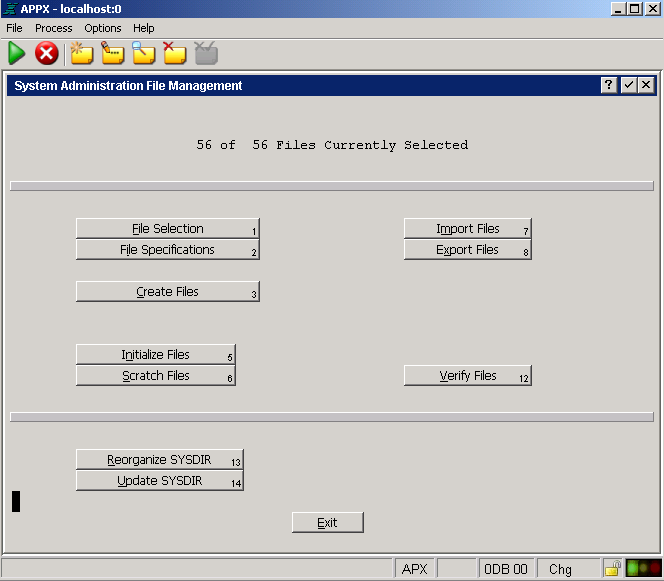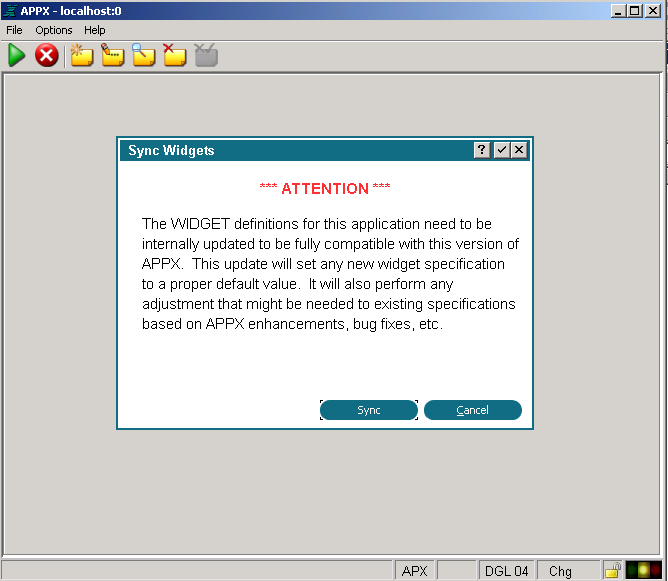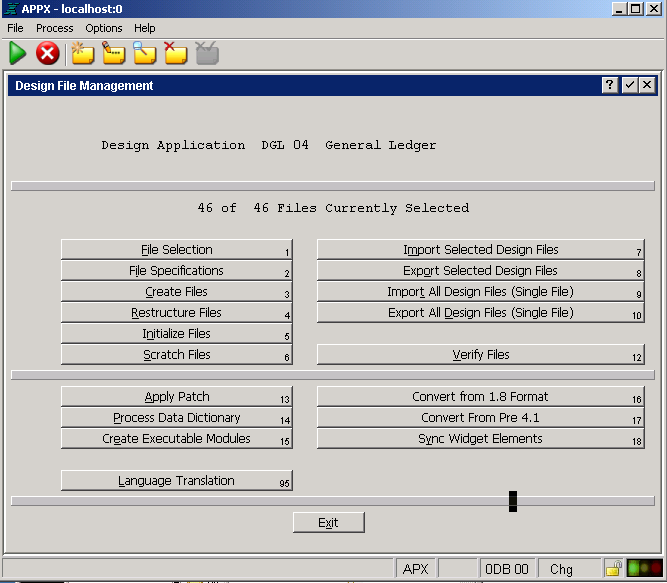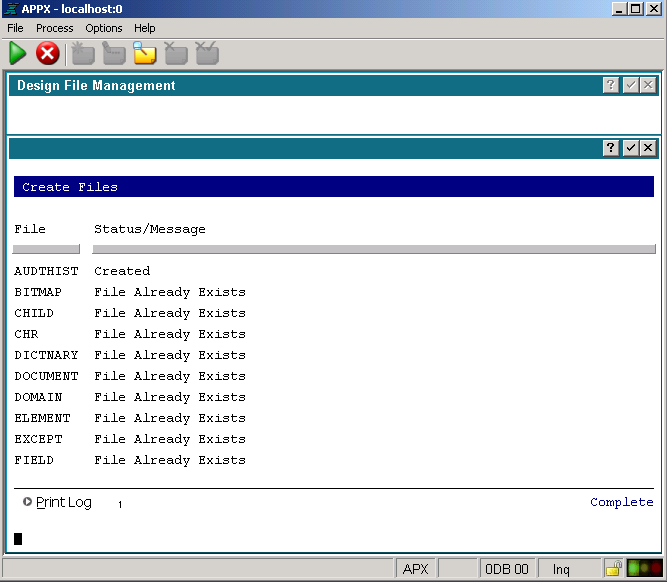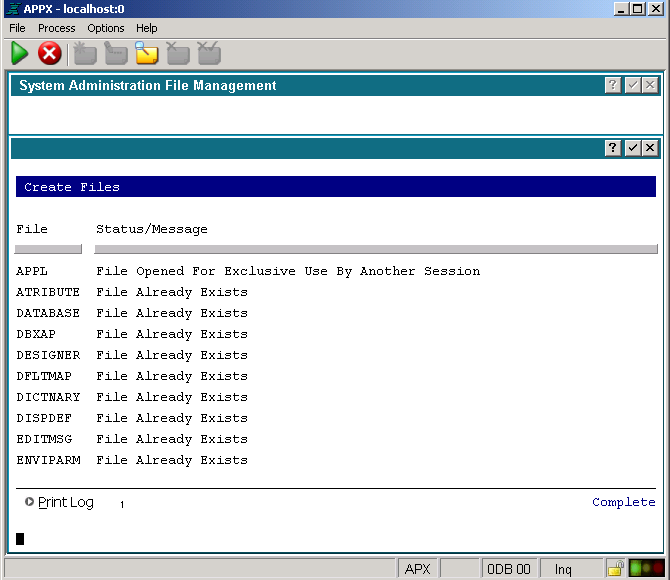
Difference: APPX500WindowsUpgradeInstallation (1 vs. 29)
Revision 292021-08-31 - AlKalter
| Line: 1 to 1 | ||||||||
|---|---|---|---|---|---|---|---|---|
APPX Windows- APPX 5 Upgrade Instructions | ||||||||
| Line: 183 to 183 | ||||||||
After executing the above command, users should be able to use the APPX 5.0.0 Desktop Client to successfully login on port 8060. For additional information on managing APPX Login Services, please refer to the complete documentation.
Final Tasks
| ||||||||
| Changed: | ||||||||
| < < |
| |||||||
| > > |
| |||||||
| ||||||||
| Line: 202 to 202 | ||||||||
| | ||||||||
| Changed: | ||||||||
| < < |
| |||||||
| > > |
| |||||||
| ||||||||
Revision 282019-02-12 - JeanNeron
| Line: 1 to 1 | ||||||||
|---|---|---|---|---|---|---|---|---|
APPX Windows- APPX 5 Upgrade Instructions | ||||||||
| Line: 182 to 182 | ||||||||
After executing the above command, users should be able to use the APPX 5.0.0 Desktop Client to successfully login on port 8060. For additional information on managing APPX Login Services, please refer to the complete documentation.
Final Tasks | ||||||||
| Changed: | ||||||||
| < < |
| |||||||
| > > |
| |||||||
| ||||||||
Revision 272016-02-25 - JeanNeron
| Line: 1 to 1 | ||||||||
|---|---|---|---|---|---|---|---|---|
APPX Windows- APPX 5 Upgrade Instructions | ||||||||
| Line: 180 to 180 | ||||||||
|
appx8060 Started appx8060 will start automatically each time you boot your system | ||||||||
| Changed: | ||||||||
| < < | After executing the above command, users should be able to use the APPX 5.0.0 Desktop Client to successfully login on port 8060. For additional information on managing APPX Login Services, please refer to the complete documentation. | |||||||
| > > | After executing the above command, users should be able to use the APPX 5.0.0 Desktop Client to successfully login on port 8060. For additional information on managing APPX Login Services, please refer to the complete documentation. | |||||||
Final Tasks
| ||||||||
Revision 262014-12-05 - JeanNeron
| Line: 1 to 1 | ||||||||
|---|---|---|---|---|---|---|---|---|
APPX Windows- APPX 5 Upgrade Instructions | ||||||||
| Line: 66 to 66 | ||||||||
Character Mode Installation | ||||||||
| Changed: | ||||||||
| < < | If you don't have access to a GUI, you can run the this installer in character mode by appending "-c" to the command line. After a few moments, the Appx Setup Wizard should display the Welcome message. Press Enter to continue the installation. | |||||||
| > > |
If you don't have access to a GUI, you can run the this installer in character mode by appending "-c" to the command line. After a few moments, the Appx Setup Wizard should display the Welcome message. Press Enter to continue the installation. | |||||||
|
C:\Appx>Appx4to5upgrade_windows -c Unpacking JRE ... Preparing JRE ... Starting Installer ... This will install Appx 4.2 to 5.0 Upgrade Application on your computer. OK [o, Enter], Cancel [c] | ||||||||
| Line: 93 to 94 | ||||||||
| System Administration (Option 3) > Database / Application (Option 3) > File Maintenance - Applications (Option 1) | ||||||||
| Changed: | ||||||||
| < < | 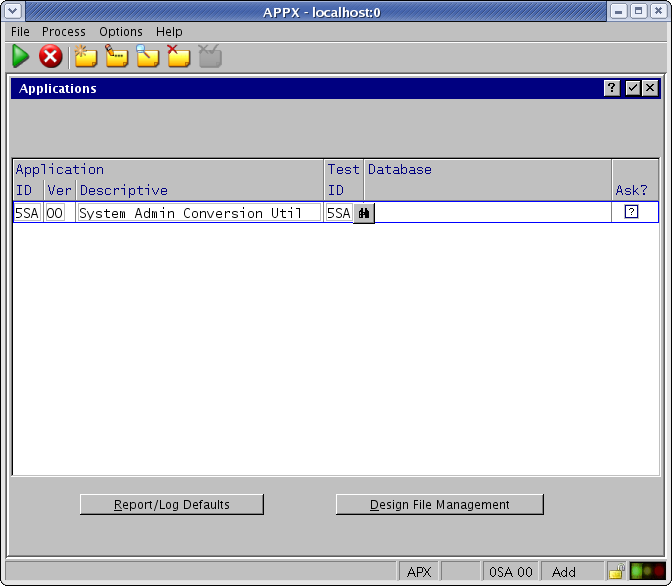 | |||||||
| > > |  | |||||||
| Create the Design Files for Application 5SA. | ||||||||
| Line: 101 to 102 | ||||||||
| The Create Files menu selection above should report "File Already Exists" for each file as shown below. If not, the application was not installed in the correct location. Repeat the installation steps above, specifing the correct location | ||||||||
| Changed: | ||||||||
| < < | 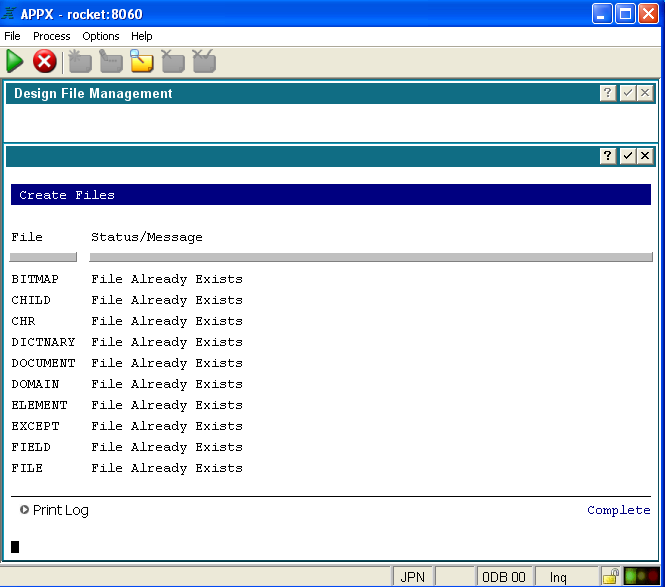 | |||||||
| > > |  | |||||||
| Add the database (5SA) for the Upgrade Application to the Databases file. System Administration (Option 3) > Database / Application (Option 3) > File Maintenance - Databases / Applications (Option 2) | ||||||||
| Changed: | ||||||||
| < < | 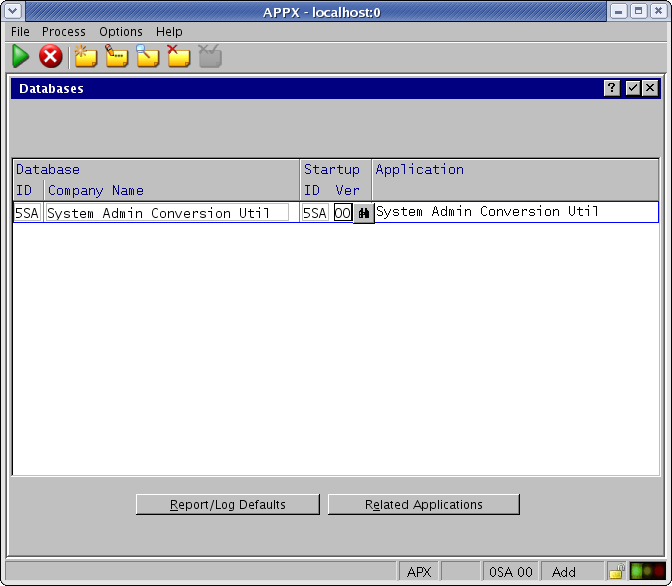 | |||||||
| > > |  | |||||||
| Run Database Management for the Upgrade Application and Database. | ||||||||
| Changed: | ||||||||
| < < | 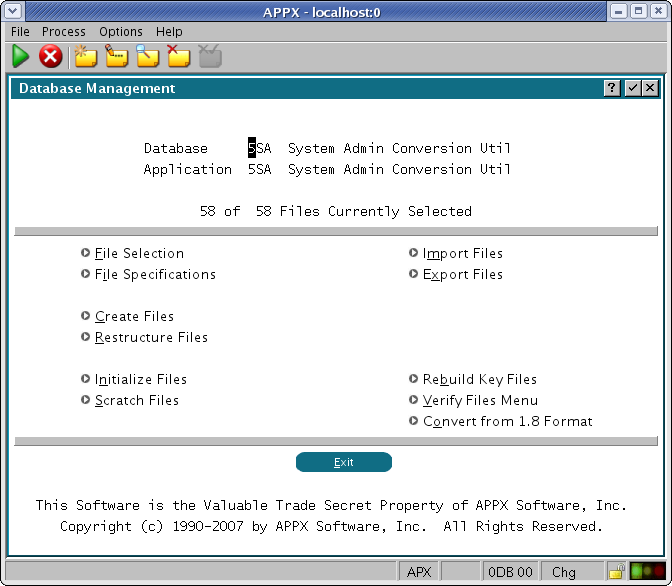 | |||||||
| > > |  | |||||||
| Run Create Files. | ||||||||
| Changed: | ||||||||
| < < | 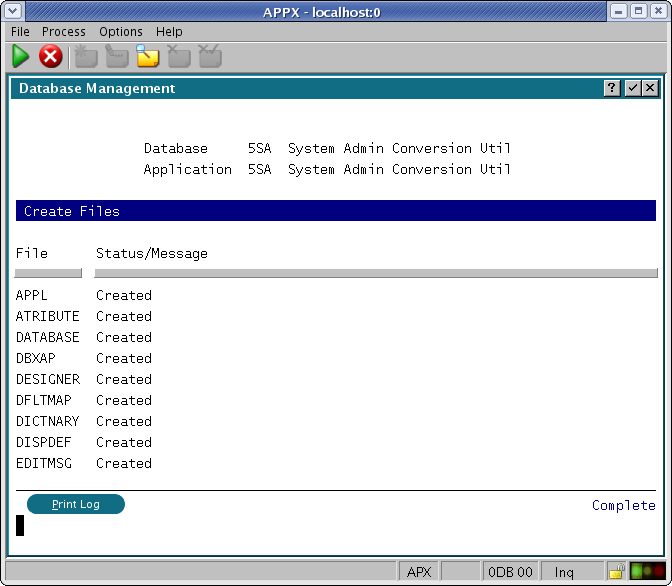 | |||||||
| > > |  | |||||||
Run the Upgrade ApplicationAfter configuring the Upgrade Application, you must run the Upgrade Utility to convert your System Administration files. Run an Application (Option 1). 5SA. | ||||||||
| Changed: | ||||||||
| < < | 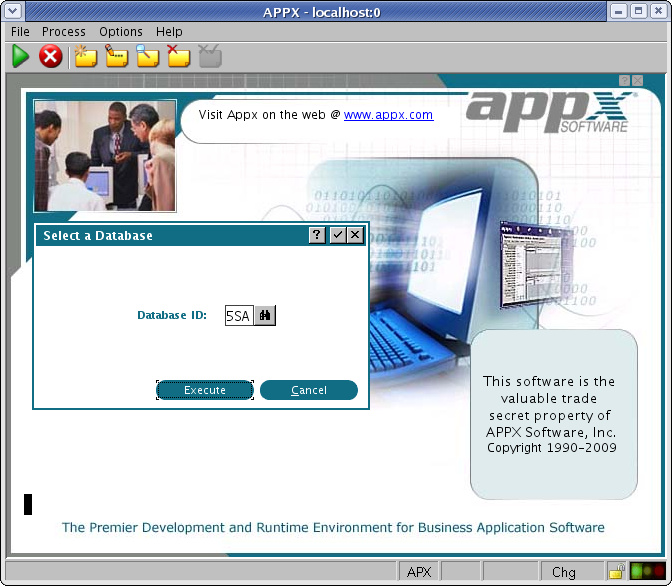 | |||||||
| > > |  | |||||||
| Click on the "Convert" button to run the conversion utility. | ||||||||
| Line: 130 to 131 | ||||||||
| The conversion utility will create a log. Specify the appropriate disposition options to print the conversion log. | ||||||||
| Changed: | ||||||||
| < < | 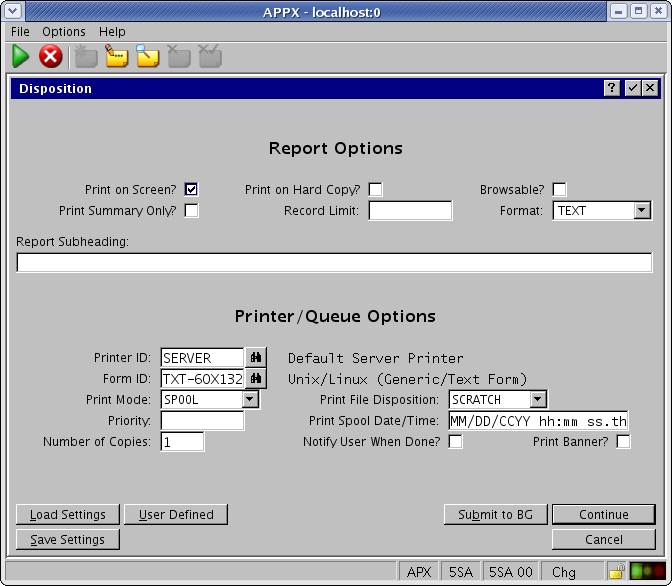 | |||||||
| > > |  | |||||||
| The conversion log will inform you of any problems that may have been encountered while running the conversion utility. | ||||||||
| Changed: | ||||||||
| < < | 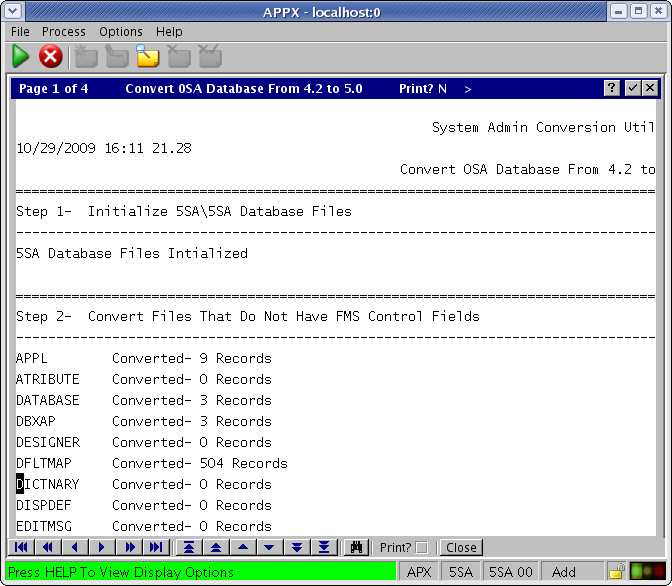 | |||||||
| > > |  | |||||||
Install the Upgraded System Administration FilesBefore you install the APPX Utility, you must first replace your old System Administration files with the new System Administration files that were created when you ran the upgrade utility to convert your System Administration files to the new APPX 5.0.0 structure. You can use a copy command similar to the example below to replace your old System Administration with the upgraded files. Be sure to edit the copy command to reference the directory where APPX is installed on your system if APPX is not installed in "C:\Appx" | ||||||||
| Line: 154 to 155 | ||||||||
Then follow these steps:
OverviewTwo different methods are provided to install APPX on Windows. There is a GUI installer and a Console Mode (character mode) installer. Most sites will use the GUI Installer, the character mode installer is intended for sites using Windows Core Server (Windows without a GUI). The same installer is used for both methods. The installer will automatically detect if it is being run as a command or from a GUI Desktop, although in some cases you may have to add "-c" to the command line to force the character installer. Regardless of which installation method is used, the result is the same. A typical APPX installation on a system where APPX has not been previously installed performs the following steps:
GUI Installation on WindowsLog in to your system as an administrative user. Download and run the APPX GUI installer (appxsetup-windows.exe) from the APPX web site or the APPX ftp server. After a few moments, the APPX Setup Wizard should display the Welcome screen. Click on the "Next" button to continue. If you are presented with a Security Warning dialog, click on the "Run" button to continue with the installation.APPX will then be installed into the specified destination directory. Character Mode InstallationIf you are running Windows Core Server, you can run the Appx installer in character mode by appending "-c" to the command line. After a few moments, the Appx Setup Wizard should display the Welcome message. Press Enter to continue the installation.
C:\Appx>setup.exe -c
Unpacking JRE ... Preparing JRE ... Starting Installer ... This will install Appx on your computer. OK [o, Enter], Cancel [c]
Next, read and accept the License agreement. Press Enter as each page is displayed. Please read the following License Agreement. You must accept the terms of this agreement before continuing with the installation. Software License APPX Utility - Release 5.0.0 _ Important! _ Please read this carefully before you click on the Accept button. Definitions: "Software License Agreement (SLA)" shall mean this Software License document and the associated *License Key document collectively. [Enter] After the agreement has been displayed, enter 1 to accept the license agreement, or 2 to cancel the installation. . . . For inquires regarding this agreement, please contact: APPX Software, Inc., 11363 San Jose Blvd., Suite 301, Jacksonville, Florida 32223, USA I accept the agreement Yes [1], No [2] Choose the directory where APPX should be installed and the other installation options. Where should Appx be installed? [C:\APPX] Create a desktop icon? Yes [y, Enter], No [n] Create a Quick Launch icon? Yes [y, Enter], No [n] | ||||||||
| Changed: | ||||||||
| < < | Install a new APPX 5.0.0 License Key | |||||||
| > > | Install a new APPX 5.x License Key | |||||||
| Changed: | ||||||||
| < < | Double click the C:\Appx\AppxDesktopClient.exe file to start the Appx Desktop Client. Click on the 'Local' tab, enter the location of the APPX engine (the appx.exe file) and click the connect button. You should be presented with the following System Registration screen. Notice that the Effective Date field on this registration is blank. Starting with APPX 5.0.0, all License Keys include an Effective Date. You must install an updated License Key before you will be able to run APPX 5.0.0. Note that in Release 5 and higher you can copy your registration to the clipboard, and APPX will detect it when you choose "Typical Import" from the "Import Menu" below. | |||||||
| > > | Double click the C:\Appx\AppxDesktopClient.exe file to start the Appx Desktop Client. Click on the 'Local' tab, enter the location of the APPX engine (the appx.exe file) and click the connect button. You should be presented with the following System Registration screen. Notice that the Effective Date field on this registration is blank. Starting with APPX 5.0.0, all License Keys include an Effective Date. You must install an updated License Key before you will be able to run APPX 5.x. Note that in Release 5 and higher you can copy your registration to the clipboard, and APPX will detect it when you choose "Typical Import" from the "Import Menu" below. | |||||||
|
| ||||||||
| Changed: | ||||||||
| < < | After installing a new 5.0.0 License Key, your System Registration screen should include an Effective Date. | |||||||
| > > | After installing a new 5.x License Key, your System Registration screen should include an Effective Date. | |||||||
Configure the new APPX Login Manager | ||||||||
| Line: 202 to 203 | ||||||||
| ||||||||
| Changed: | ||||||||
| < < |
| |||||||
| > > |
| |||||||
| ||||||||
| Changed: | ||||||||
| < < |
| |||||||
| > > |
| |||||||
Comments: | ||||||||
Revision 252012-03-13 - JoeOrtagus
Revision 242011-03-25 - JeanNeron
| Line: 1 to 1 | ||||||||
|---|---|---|---|---|---|---|---|---|
APPX Windows- APPX 5 Upgrade Instructions | ||||||||
| Line: 27 to 27 | ||||||||
| ||||||||
| Changed: | ||||||||
| < < |
| |||||||
| > > |
| |||||||
| ||||||||
| Line: 182 to 182 | ||||||||
After executing the above command, users should be able to use the APPX 5.0.0 Desktop Client to successfully login on port 8060. For additional information on managing APPX Login Services, please refer to the complete documentation.
Final Tasks | ||||||||
| Added: | ||||||||
| > > |
| |||||||
| ||||||||
Revision 232011-01-27 - JoeOrtagus
| Line: 1 to 1 | ||||||||
|---|---|---|---|---|---|---|---|---|
APPX Windows- APPX 5 Upgrade Instructions | ||||||||
| Line: 27 to 27 | ||||||||
| ||||||||
| Changed: | ||||||||
| < < |
| |||||||
| > > |
| |||||||
| ||||||||
Revision 222011-01-27 - JoeOrtagus
| Line: 1 to 1 | ||||||||
|---|---|---|---|---|---|---|---|---|
APPX Windows- APPX 5 Upgrade Instructions | ||||||||
| Line: 27 to 27 | ||||||||
| ||||||||
| Added: | ||||||||
| > > |
| |||||||
| ||||||||
Revision 212011-01-26 - JoeOrtagus
| Line: 1 to 1 | ||||||||
|---|---|---|---|---|---|---|---|---|
APPX Windows- APPX 5 Upgrade Instructions | ||||||||
| Line: 25 to 25 | ||||||||
| ||||||||
| Added: | ||||||||
| > > |
| |||||||
| ||||||||
| Line: 64 to 65 | ||||||||
Character Mode Installation | ||||||||
| Changed: | ||||||||
| < < | If you don't have access to a GUI, you can run the this installer in character mode by appending "-c" to the command line. After a few moments, the Appx Setup Wizard should display the Welcome message. Press Enter to continue the installation. | |||||||
| > > | If you don't have access to a GUI, you can run the this installer in character mode by appending "-c" to the command line. After a few moments, the Appx Setup Wizard should display the Welcome message. Press Enter to continue the installation. | |||||||
|
C:\Appx>Appx4to5upgrade_windows -c Unpacking JRE ... Preparing JRE ... Starting Installer ... This will install Appx 4.2 to 5.0 Upgrade Application on your computer. OK [o, Enter], Cancel [c] | ||||||||
Revision 202011-01-04 - GaryRogers
| Line: 1 to 1 | ||||||||
|---|---|---|---|---|---|---|---|---|
APPX Windows- APPX 5 Upgrade Instructions | ||||||||
| Line: 64 to 64 | ||||||||
Character Mode Installation | ||||||||
| Changed: | ||||||||
| < < | If you don't have access to a GUI, you can run the this installer in character mode by appending "-c" to the command line. After a few moments, the Appx Setup Wizard should display the Welcome message. Press Enter to continue the installation. | |||||||
| > > | If you don't have access to a GUI, you can run the this installer in character mode by appending "-c" to the command line. After a few moments, the Appx Setup Wizard should display the Welcome message. Press Enter to continue the installation. | |||||||
|
C:\Appx>Appx4to5upgrade_windows -c Unpacking JRE ... Preparing JRE ... Starting Installer ... This will install Appx 4.2 to 5.0 Upgrade Application on your computer. OK [o, Enter], Cancel [c] | ||||||||
| Line: 139 to 139 | ||||||||
| COPY C:\Appx\data\5SA\5SA\Data\ C:\Appx\data\0SA\Data\* | ||||||||
| Added: | ||||||||
| > > | If you are prompted to overwrite any files answer Yes or All. | |||||||
| You should also remove the System Administration structure files. You can use a delete command similar to the example below to remove your System Administration structure files. Be sure to edit the command to reference the directory where APPX is installed on your system if APPX is not installed in "C:\Appx". DEL C:\Appx\data\0SA\Struct\* | ||||||||
| Line: 155 to 157 | ||||||||
| Double click the C:\Appx\AppxDesktopClient.exe file to start the Appx Desktop Client. Click on the 'Local' tab, enter the location of the APPX engine (the appx.exe file) and click the connect button. You should be presented with the following System Registration screen. Notice that the Effective Date field on this registration is blank. Starting with APPX 5.0.0, all License Keys include an Effective Date. You must install an updated License Key before you will be able to run APPX 5.0.0. Note that in Release 5 and higher you can copy your registration to the clipboard, and APPX will detect it when you choose "Typical Import" from the "Import Menu" below. | ||||||||
| Changed: | ||||||||
| < < | 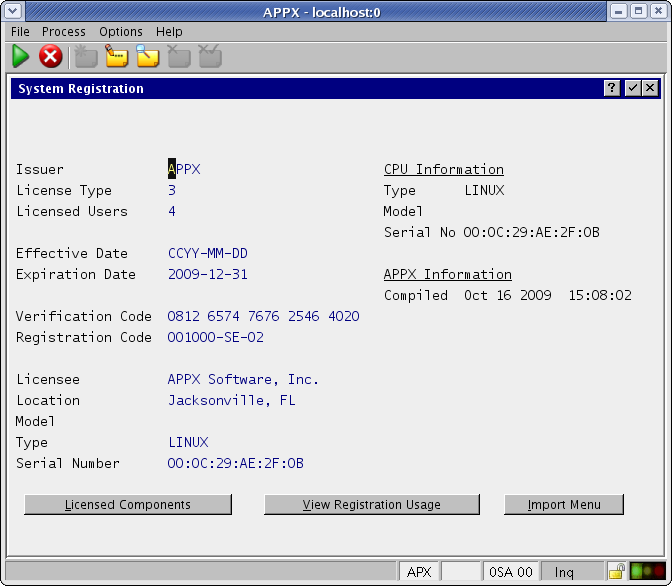 | |||||||
| > > | ||||||||
| After installing a new 5.0.0 License Key, your System Registration screen should include an Effective Date. | ||||||||
| Changed: | ||||||||
| < < | 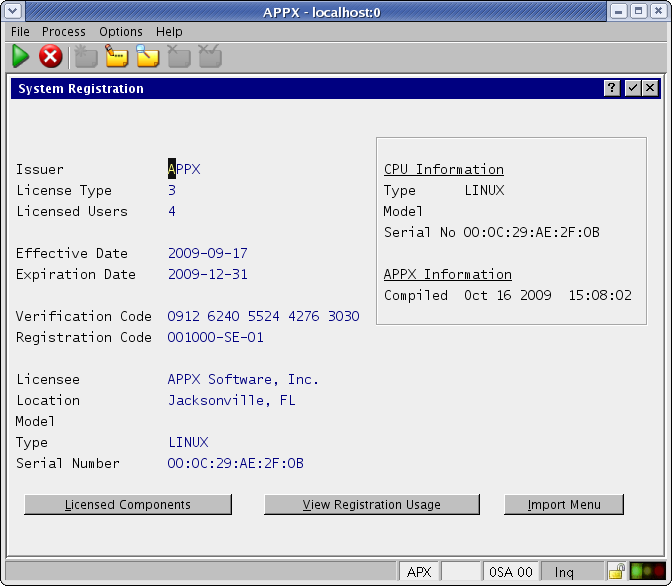 | |||||||
| > > | ||||||||
Configure the new APPX Login ManagerAPPX 5 includes the new APPX Login Manager service. This service replaces the Connection Manager (AppxdSvc) which was included with APPX releases prior to APPX 5.0.0. The old Connection Manager will not work with APPX 5 and higher, and should not be used. You should remove the services installed by appxdsvc using the '-remove' keyword: | ||||||||
| Line: 189 to 191 | ||||||||
| ||||||||
| Added: | ||||||||
| > > | | |||||||
| | ||||||||
| Changed: | ||||||||
| < < |
| |||||||
| > > |
| |||||||
| | ||||||||
| Added: | ||||||||
| > > | | |||||||
| ||||||||
| Line: 219 to 225 | ||||||||
| ||||||||
| Added: | ||||||||
| > > |
| |||||||
Revision 192011-01-04 - GaryRogers
| Line: 1 to 1 | |||||||||||
|---|---|---|---|---|---|---|---|---|---|---|---|
APPX Windows- APPX 5 Upgrade Instructions | |||||||||||
| Line: 44 to 44 | |||||||||||
| Download and run the installer for the APPX 4.2.a to APPX 5 upgrade application Appx4to5upgrade-windows.exe from the APPX web site or the APPX ftp server. After a few moments, the APPX 4.2 to 5.0 Upgrade Application Setup Wizard should display the Welcome screen. Click on the "Next" button to continue. | |||||||||||
| Changed: | |||||||||||
| < < |  | ||||||||||
| > > | |||||||||||
| Read the Installation Instructions and then click on the "Next" button to continue. | |||||||||||
| Changed: | |||||||||||
| < < | 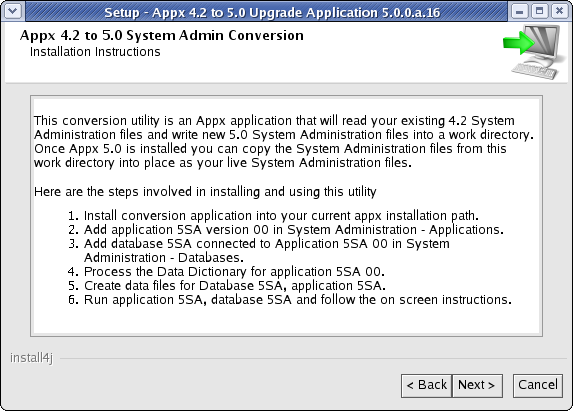 | ||||||||||
| > > | |||||||||||
| Specify the Destination Directory into which the upgrade utility is to be installed. The directory that you specify must be the directory where APPX 4.2.a is installed on your system. | |||||||||||
| Changed: | |||||||||||
| < < | 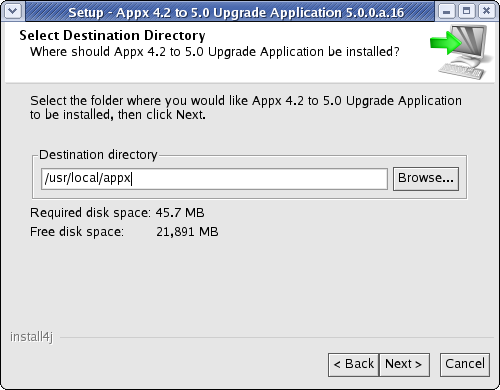 | ||||||||||
| > > | |||||||||||
| The APPX Upgrade Application (5SA Version 00) will then be installed into the specified destination directory. | |||||||||||
| Changed: | |||||||||||
| < < | 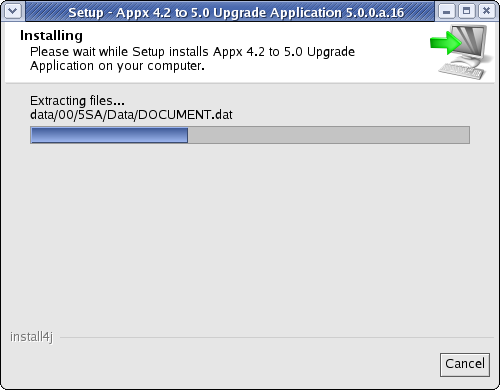 | ||||||||||
| > > | |||||||||||
| When the installation wizard displays the final screen, click on the Finish button to end the installation wizard. | |||||||||||
| Changed: | |||||||||||
| < < | 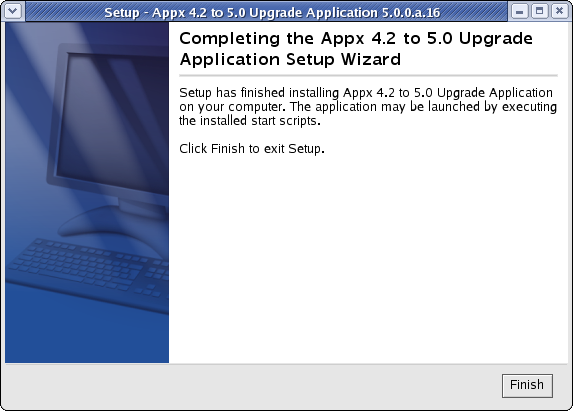 | ||||||||||
| > > | |||||||||||
Character Mode Installation | |||||||||||
| Line: 214 to 214 | |||||||||||
| |||||||||||
| Added: | |||||||||||
| > > |
| ||||||||||
Revision 182010-11-10 - JeanNeron
| Line: 1 to 1 | ||||||||
|---|---|---|---|---|---|---|---|---|
APPX Windows- APPX 5 Upgrade Instructions | ||||||||
| Line: 194 to 194 | ||||||||
| ||||||||
| Changed: | ||||||||
| < < |
| |||||||
| > > |
| |||||||
| ||||||||
Revision 172010-11-09 - JeanNeron
| Line: 1 to 1 | ||||||||
|---|---|---|---|---|---|---|---|---|
APPX Windows- APPX 5 Upgrade Instructions | ||||||||
| Line: 193 to 193 | ||||||||
| ||||||||
| Added: | ||||||||
| > > |
| |||||||
| ||||||||
Revision 162010-11-09 - JeanNeron
| Line: 1 to 1 | ||||||||
|---|---|---|---|---|---|---|---|---|
APPX Windows- APPX 5 Upgrade Instructions | ||||||||
Revision 152010-11-09 - JeanNeron
| Line: 1 to 1 | ||||||||
|---|---|---|---|---|---|---|---|---|
APPX Windows- APPX 5 Upgrade Instructions | ||||||||
| Line: 13 to 13 | ||||||||
| To upgrade your existing APPX Windows installation from APPX 4.2.a to APPX 5, you must complete the following steps: | ||||||||
| Deleted: | ||||||||
| < < |
| |||||||
| ||||||||
| Line: 28 to 27 | ||||||||
| ||||||||
| Added: | ||||||||
| > > |
| |||||||
Convert Your System Administration Files | ||||||||
| Line: 195 to 195 | ||||||||
| ||||||||
| Added: | ||||||||
| > > |
| |||||||
Comments: | ||||||||
Revision 142010-09-13 - JoeOrtagus
| Line: 1 to 1 | ||||||||
|---|---|---|---|---|---|---|---|---|
APPX Windows- APPX 5 Upgrade Instructions | ||||||||
| Line: 24 to 24 | ||||||||
| ||||||||
| Added: | ||||||||
| > > |
| |||||||
| ||||||||
Revision 132010-09-09 - JoeOrtagus
| Line: 1 to 1 | |||||||||||||||
|---|---|---|---|---|---|---|---|---|---|---|---|---|---|---|---|
APPX Windows- APPX 5 Upgrade Instructions | |||||||||||||||
| Line: 88 to 88 | |||||||||||||||
| Add the upgrade application (5SA 00) to the Applications file. | |||||||||||||||
| Added: | |||||||||||||||
| > > | System Administration (Option 3) > Database / Application (Option 3) > File Maintenance - Applications (Option 1) | ||||||||||||||
 | |||||||||||||||
| Changed: | |||||||||||||||
| < < | Create the Design Files for Application 5SA. APPX should report "File Already Exists" for each file. If not, the application was not installed in the correct location. Repeat the installation steps above, specifing the correct location | ||||||||||||||
| > > | Create the Design Files for Application 5SA.
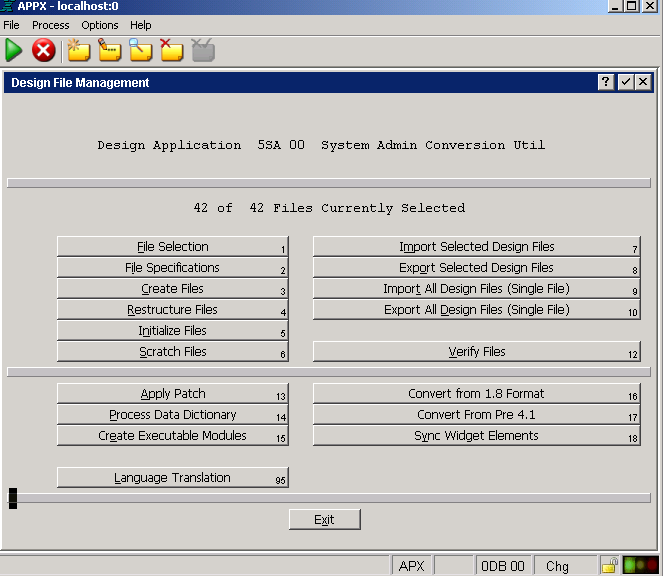 The Create Files menu selection above should report "File Already Exists" for each file as shown below. If not, the application was not installed in the correct location. Repeat the installation steps above, specifing the correct location
The Create Files menu selection above should report "File Already Exists" for each file as shown below. If not, the application was not installed in the correct location. Repeat the installation steps above, specifing the correct location | ||||||||||||||
 Add the database (5SA) for the Upgrade Application to the Databases file.
Add the database (5SA) for the Upgrade Application to the Databases file. | |||||||||||||||
| Added: | |||||||||||||||
| > > | System Administration (Option 3) > Database / Application (Option 3) > File Maintenance - Databases / Applications (Option 2) | ||||||||||||||
 Run Database Management for the Upgrade Application and Database.
Run Database Management for the Upgrade Application and Database. | |||||||||||||||
| Line: 109 to 117 | |||||||||||||||
| After configuring the Upgrade Application, you must run the Upgrade Utility to convert your System Administration files. | |||||||||||||||
| Added: | |||||||||||||||
| > > | Run an Application (Option 1). 5SA. | ||||||||||||||
 Click on the "Convert" button to run the conversion utility.
Click on the "Convert" button to run the conversion utility. | |||||||||||||||
| Changed: | |||||||||||||||
| < < | 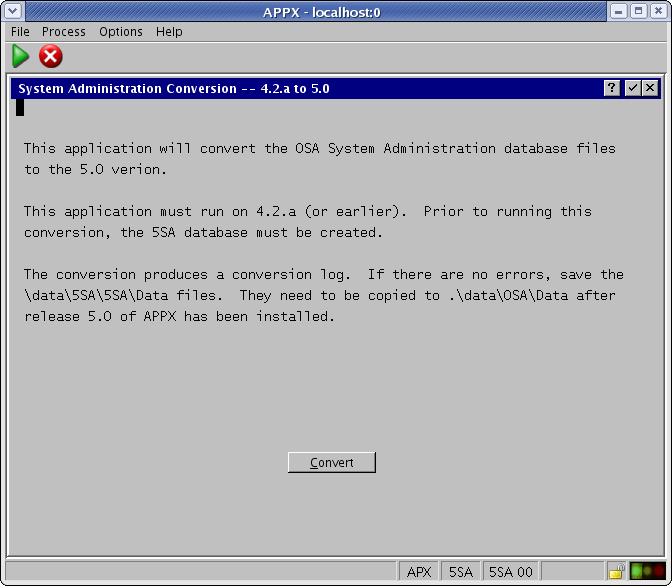 | ||||||||||||||
| > > | 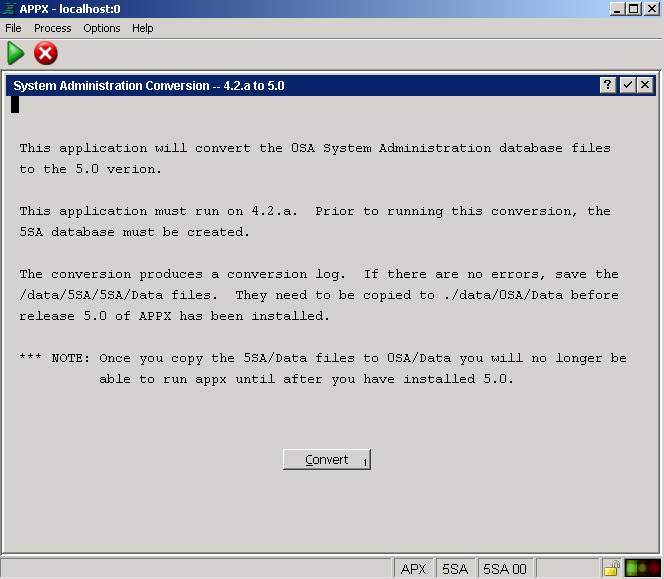 | ||||||||||||||
| The conversion utility will create a log. Specify the appropriate disposition options to print the conversion log. | |||||||||||||||
| Line: 167 to 177 | |||||||||||||||
After executing the above command, users should be able to use the APPX 5.0.0 Desktop Client to successfully login on port 8060. For additional information on managing APPX Login Services, please refer to the complete documentation.
Final Tasks | |||||||||||||||
| Added: | |||||||||||||||
| > > |
| ||||||||||||||
| |||||||||||||||
| Added: | |||||||||||||||
| > > | | ||||||||||||||
| |||||||||||||||
| Changed: | |||||||||||||||
| < < |
| ||||||||||||||
| > > |
| ||||||||||||||
| |||||||||||||||
| Added: | |||||||||||||||
| > > |
| ||||||||||||||
| |||||||||||||||
| Added: | |||||||||||||||
| > > | | ||||||||||||||
| |||||||||||||||
| Line: 184 to 203 | |||||||||||||||
-- SteveFrizzell - 2 Nov 2009 \ No newline at end of file | |||||||||||||||
| Added: | |||||||||||||||
| > > |
| ||||||||||||||
Revision 122010-08-30 - JoeOrtagus
| Line: 1 to 1 | ||||||||
|---|---|---|---|---|---|---|---|---|
APPX Windows- APPX 5 Upgrade Instructions | ||||||||
| Line: 126 to 126 | ||||||||
| Before you install the APPX Utility, you must first replace your old System Administration files with the new System Administration files that were created when you ran the upgrade utility to convert your System Administration files to the new APPX 5.0.0 structure. You can use a copy command similar to the example below to replace your old System Administration with the upgraded files. Be sure to edit the copy command to reference the directory where APPX is installed on your system if APPX is not installed in "C:\Appx" | ||||||||
| Changed: | ||||||||
| < < | COPY C:\Appx\data\5SA\5SA\Data\ C:\Appx\data\0SA\Data* | |||||||
| > > | COPY C:\Appx\data\5SA\5SA\Data\ C:\Appx\data\0SA\Data\* | |||||||
| You should also remove the System Administration structure files. You can use a delete command similar to the example below to remove your System Administration structure files. Be sure to edit the command to reference the directory where APPX is installed on your system if APPX is not installed in "C:\Appx". | ||||||||
Revision 112010-08-30 - JoeOrtagus
| Line: 1 to 1 | ||||||||
|---|---|---|---|---|---|---|---|---|
APPX Windows- APPX 5 Upgrade Instructions | ||||||||
| Line: 41 to 41 | ||||||||
| Log in to your system as an administrative user. | ||||||||
| Changed: | ||||||||
| < < | Download and run the installer for the APPX 4.2.a to APPX 5 upgrade application Appx4to5upgrade_windows.exe from the APPX web site or the APPX ftp server. After a few moments, the APPX 4.2 to 5.0 Upgrade Application Setup Wizard should display the Welcome screen. Click on the "Next" button to continue. | |||||||
| > > | Download and run the installer for the APPX 4.2.a to APPX 5 upgrade application Appx4to5upgrade-windows.exe from the APPX web site or the APPX ftp server. After a few moments, the APPX 4.2 to 5.0 Upgrade Application Setup Wizard should display the Welcome screen. Click on the "Next" button to continue. | |||||||
 | ||||||||
Revision 102010-07-08 - JeanNeron
| Line: 1 to 1 | ||||||||
|---|---|---|---|---|---|---|---|---|
APPX Windows- APPX 5 Upgrade Instructions | ||||||||
| Line: 172 to 172 | ||||||||
| ||||||||
| Changed: | ||||||||
| < < |
| |||||||
| > > |
| |||||||
Comments: | ||||||||
Revision 92010-02-23 - JeanNeron
| Line: 1 to 1 | ||||||||
|---|---|---|---|---|---|---|---|---|
APPX Windows- APPX 5 Upgrade Instructions | ||||||||
| Line: 63 to 63 | ||||||||
Character Mode Installation | ||||||||
| Changed: | ||||||||
| < < | If you don't have access to a GUI, you can run the this installer in character mode by appending "-c" to the command line. After a few moments, the Appx Setup Wizard should display the Welcome message. Press Enter to continue the installation. | |||||||
| > > | If you don't have access to a GUI, you can run the this installer in character mode by appending "-c" to the command line. After a few moments, the Appx Setup Wizard should display the Welcome message. Press Enter to continue the installation. | |||||||
|
C:\Appx>Appx4to5upgrade_windows -c Unpacking JRE ... Preparing JRE ... Starting Installer ... This will install Appx 4.2 to 5.0 Upgrade Application on your computer. OK [o, Enter], Cancel [c] | ||||||||
| Line: 169 to 169 | ||||||||
Final Tasks
| ||||||||
| Changed: | ||||||||
| < < |
| |||||||
| > > |
| |||||||
Comments: | ||||||||
Revision 82010-01-30 - RayPelegrino
| Line: 1 to 1 | ||||||||
|---|---|---|---|---|---|---|---|---|
APPX Windows- APPX 5 Upgrade Instructions | ||||||||
Revision 72010-01-08 - JeanNeron
| Line: 1 to 1 | ||||||||
|---|---|---|---|---|---|---|---|---|
APPX Windows- APPX 5 Upgrade Instructions | ||||||||
Revision 62009-12-08 - JeanNeron
| Line: 1 to 1 | ||||||||
|---|---|---|---|---|---|---|---|---|
APPX Windows- APPX 5 Upgrade Instructions | ||||||||
| Line: 26 to 26 | ||||||||
| ||||||||
| Deleted: | ||||||||
| < < |
| |||||||
| ||||||||
| Line: 135 to 132 | ||||||||
| DEL C:\Appx\data\0SA\Struct\* | ||||||||
| Changed: | ||||||||
| < < | You are now ready to install Release 5 on top of your existing installation. Follow these steps: | |||||||
| > > | You are now ready to install Release 5 on top of your existing installation. Before installing APPX you should:
| |||||||
OverviewTwo different methods are provided to install APPX on Windows. There is a GUI installer and a Console Mode (character mode) installer. Most sites will use the GUI Installer, the character mode installer is intended for sites using Windows Core Server (Windows without a GUI). The same installer is used for both methods. The installer will automatically detect if it is being run as a command or from a GUI Desktop, although in some cases you may have to add "-c" to the command line to force the character installer. Regardless of which installation method is used, the result is the same. A typical APPX installation on a system where APPX has not been previously installed performs the following steps:
GUI Installation on WindowsLog in to your system as an administrative user. Download and run the APPX GUI installer (appxsetup-windows.exe) from the APPX web site or the APPX ftp server. After a few moments, the APPX Setup Wizard should display the Welcome screen. Click on the "Next" button to continue. If you are presented with a Security Warning dialog, click on the "Run" button to continue with the installation.APPX will then be installed into the specified destination directory. Character Mode InstallationIf you are running Windows Core Server, you can run the Appx installer in character mode by appending "-c" to the command line. After a few moments, the Appx Setup Wizard should display the Welcome message. Press Enter to continue the installation.
C:\Appx>setup.exe -c
Unpacking JRE ... Preparing JRE ... Starting Installer ... This will install Appx on your computer. OK [o, Enter], Cancel [c]
Next, read and accept the License agreement. Press Enter as each page is displayed. Please read the following License Agreement. You must accept the terms of this agreement before continuing with the installation. Software License APPX Utility - Release 5.0.0 _ Important! _ Please read this carefully before you click on the Accept button. Definitions: "Software License Agreement (SLA)" shall mean this Software License document and the associated *License Key document collectively. [Enter] After the agreement has been displayed, enter 1 to accept the license agreement, or 2 to cancel the installation. . . . For inquires regarding this agreement, please contact: APPX Software, Inc., 11363 San Jose Blvd., Suite 301, Jacksonville, Florida 32223, USA I accept the agreement Yes [1], No [2] Choose the directory where APPX should be installed and the other installation options. Where should Appx be installed? [C:\APPX] Create a desktop icon? Yes [y, Enter], No [n] Create a Quick Launch icon? Yes [y, Enter], No [n] Install a new APPX 5.0.0 License Key | ||||||||
Revision 52009-12-08 - GaryRogers
| Line: 1 to 1 | ||||||||
|---|---|---|---|---|---|---|---|---|
APPX Windows- APPX 5 Upgrade Instructions | ||||||||
| Line: 9 to 9 | ||||||||
|
| ||||||||
| Changed: | ||||||||
| < < | Warning - These instructions specifically apply to upgrading from APPX 4.2.a to APPX 5. If you are upgrading from an older release of APPX, these instructions may not be applicable. You should consider upgrading to APPX 4.2.a first and then upgrading to APPX 5. | |||||||
| > > | Warning - These instructions specifically apply to upgrading from APPX 4.2.a to APPX 5. If you are upgrading from an older release of APPX you must upgrade to APPX 4.2.a first and then upgrade to APPX 5. | |||||||
| To upgrade your existing APPX Windows installation from APPX 4.2.a to APPX 5, you must complete the following steps: | ||||||||
| Line: 34 to 34 | ||||||||
Convert Your System Administration Files | ||||||||
| Changed: | ||||||||
| < < | The first step of upgrading your APPX 4.2.a installation to APPX 5 is to convert your System Administration files to the new APPX 5 format. The System Administration files for APPX 4.2.a are not compatible with APPX 5 and must be converted to the APPX 5 format. | |||||||
| > > | The first step of upgrading your APPX 4.2.a installation to APPX 5 is to convert your System Administration files to the new APPX 5 format. The System Administration files for APPX 4.2.a are not compatible with APPX 5 and must be converted to the APPX 5 format. Follow the directions below to convert your System Administration files. | |||||||
Install the Upgrade ApplicationTwo different methods are provided to install the upgrade application on Windows. There is a GUI installer and a Console Mode (character mode) installer. Most sites will use the GUI Installer, the character mode installer is intended for sites using Windows Core Server (Windows without a GUI). The same installer is used for both methods. The installer will automatically detect if it is being run as a command or from a GUI Desktop, although in some cases you may have to add "-c" to the command line to force the character installer. Regardless of which installation method is used, the result is the same. | ||||||||
| Line: 165 to 165 | ||||||||
After executing the above command, users should be able to use the APPX 5.0.0 Desktop Client to successfully login on port 8060. For additional information on managing APPX Login Services, please refer to the complete documentation.
Final Tasks | ||||||||
| Added: | ||||||||
| > > |
| |||||||
| ||||||||
| Deleted: | ||||||||
| < < |
| |||||||
Comments: | ||||||||
Revision 42009-11-25 - JeffPrentice
| Line: 1 to 1 | ||||||||
|---|---|---|---|---|---|---|---|---|
APPX Windows- APPX 5 Upgrade Instructions | ||||||||
| Line: 44 to 44 | ||||||||
| Log in to your system as an administrative user. | ||||||||
| Changed: | ||||||||
| < < | Download and run the installer for the APPX 4.2.a to APPX 5 upgrade application Appx4to5upgrade_windows.exe from the APPX web site or the APPX ftp serverAfter a few moments, the APPX 4.2 to 5.0 Upgrade Application Setup Wizard should display the Welcome screen. Click on the "Next" button to continue. | |||||||
| > > | Download and run the installer for the APPX 4.2.a to APPX 5 upgrade application Appx4to5upgrade_windows.exe from the APPX web site or the APPX ftp server. After a few moments, the APPX 4.2 to 5.0 Upgrade Application Setup Wizard should display the Welcome screen. Click on the "Next" button to continue. | |||||||
 | ||||||||
Revision 32009-11-20 - JeanNeron
| Line: 1 to 1 | ||||||||
|---|---|---|---|---|---|---|---|---|
APPX Windows- APPX 5 Upgrade Instructions | ||||||||
| Line: 171 to 171 | ||||||||
| ||||||||
| Changed: | ||||||||
| < < |
| |||||||
| > > |
| |||||||
Comments: | ||||||||
Revision 22009-11-12 - JeanNeron
| Line: 1 to 1 | ||||||||
|---|---|---|---|---|---|---|---|---|
APPX Windows- APPX 5 Upgrade Instructions | ||||||||
| Line: 153 to 153 | ||||||||
| C:\Appx\tools>appxdsvc -remove -name=Appx8060 | ||||||||
| Changed: | ||||||||
| < < | To configure and start the new APPX Login Manager service, log in as the root user and execute a command similar to the following: | |||||||
| > > | To configure and start the new APPX Login Manager service, log in as an administrative user and execute a command similar to the following: | |||||||
| Changed: | ||||||||
| < < | /usr/local/appx/services/appxLoginMgr -install -name=appxLogin8060 -port=8060 | |||||||
| > > | C:\Appx>CD services C:\Appx\services>appxLoginMgr.exe -install -name=appx8060 -displayName=appx8060 -port=8060 -engine=C:\Appx\appx.exe | |||||||
| Changed: | ||||||||
| < < | Warning - the engine that you named has the setuid bit enabled, you may not want that bit set for the authentication method that you have chosen (OS-User) To turn off the setuid bit, chmod u-s ../appx Configuration written to: appxLogin8060.ini Environment written to: appxLogin8060.env Service script written to: /etc/init.d/appxLogin8060 Configuration complete Registering service Starting appxLogin8060: [ OK ] Warning - the engine that you named has the setuid bit enabled, you may not want that bit set for the authentication method that you have chosen (OS-User) To turn off the setuid bit, chmod u-s ../appx up and running (process 31754 servicing port 8060) Installation Complete_ | |||||||
| > > | You should see the following messages:
appx8060 Created appx8060 Configured appx8060 Started appx8060 will start automatically each time you boot your system | |||||||
After executing the above command, users should be able to use the APPX 5.0.0 Desktop Client to successfully login on port 8060. For additional information on managing APPX Login Services, please refer to the complete documentation.
Final Tasks | ||||||||
| Line: 181 to 170 | ||||||||
| ||||||||
| Changed: | ||||||||
| < < |
| |||||||
| > > |
| |||||||
Comments: | ||||||||
Revision 12009-11-12 - JeanNeron
| Line: 1 to 1 | ||||||||
|---|---|---|---|---|---|---|---|---|
| Added: | ||||||||
| > > |
APPX Windows- APPX 5 Upgrade InstructionsThis page provides the information needed to upgrade an existing APPX 4.2.a Windows installation to APPX 5.OverviewWarning - These instructions specifically apply to upgrading from APPX 4.2.a to APPX 5. If you are upgrading from an older release of APPX, these instructions may not be applicable. You should consider upgrading to APPX 4.2.a first and then upgrading to APPX 5. To upgrade your existing APPX Windows installation from APPX 4.2.a to APPX 5, you must complete the following steps:
Preliminary Tasks
Convert Your System Administration FilesThe first step of upgrading your APPX 4.2.a installation to APPX 5 is to convert your System Administration files to the new APPX 5 format. The System Administration files for APPX 4.2.a are not compatible with APPX 5 and must be converted to the APPX 5 format.Install the Upgrade ApplicationTwo different methods are provided to install the upgrade application on Windows. There is a GUI installer and a Console Mode (character mode) installer. Most sites will use the GUI Installer, the character mode installer is intended for sites using Windows Core Server (Windows without a GUI). The same installer is used for both methods. The installer will automatically detect if it is being run as a command or from a GUI Desktop, although in some cases you may have to add "-c" to the command line to force the character installer. Regardless of which installation method is used, the result is the same.GUI InstallationLog in to your system as an administrative user. Download and run the installer for the APPX 4.2.a to APPX 5 upgrade application Appx4to5upgrade_windows.exe from the APPX web site or the APPX ftp serverAfter a few moments, the APPX 4.2 to 5.0 Upgrade Application Setup Wizard should display the Welcome screen. Click on the "Next" button to continue. Read the Installation Instructions and then click on the "Next" button to continue.
Read the Installation Instructions and then click on the "Next" button to continue.
 Specify the Destination Directory into which the upgrade utility is to be installed. The directory that you specify must be the directory where APPX 4.2.a is installed on your system.
Specify the Destination Directory into which the upgrade utility is to be installed. The directory that you specify must be the directory where APPX 4.2.a is installed on your system.
 The APPX Upgrade Application (5SA Version 00) will then be installed into the specified destination directory.
The APPX Upgrade Application (5SA Version 00) will then be installed into the specified destination directory.
 When the installation wizard displays the final screen, click on the Finish button to end the installation wizard.
When the installation wizard displays the final screen, click on the Finish button to end the installation wizard.

Character Mode InstallationIf you don't have access to a GUI, you can run the this installer in character mode by appending "-c" to the command line. After a few moments, the Appx Setup Wizard should display the Welcome message. Press Enter to continue the installation.
C:\Appx>Appx4to5upgrade_windows -cUnpacking JRE ... Preparing JRE ... Starting Installer ... This will install Appx 4.2 to 5.0 Upgrade Application on your computer. OK [o, Enter], Cancel [c] Next, the installation and conversion instructions will be displayed. Press Enter when you are ready to continue. Installation Instructions This conversion utility is an Appx application that will read your existing 4.2 System Administration files and write new 5.0 System Administration files into a work directory. Once Appx 5.0 is installed you can copy the System Administration files from this work directory into place as your live System Administration files. Here are the steps involved in installing and using this utility 1. Install conversion application into your current appx installation path. 2. Add application 5SA version 00 in System Administration - Applications. 3. Add database 5SA connected to Application 5SA 00 in System Administration - Databases. 4. Process the Data Dictionary for application 5SA 00. 5. Create data files for Database 5SA, application 5SA. 6. Run application 5SA, database 5SA and follow the on screen instructions. Choose the location for the installation. Where should Appx 4.2 to 5.0 Upgrade Application be installed? [C:\Appx] The files will then be copied to your hard disk. When this is finished, you are ready to continue with 'Configure the Upgrade Application' Configure the Upgrade ApplicationAfter installing the Upgrade Application, you must run APPX as an APPX System Administrator and configure the Upgrade Application. Add the upgrade application (5SA 00) to the Applications file. Create the Design Files for Application 5SA. APPX should report "File Already Exists" for each file. If not, the application was not installed in the correct location. Repeat the installation steps above, specifing the correct location
Create the Design Files for Application 5SA. APPX should report "File Already Exists" for each file. If not, the application was not installed in the correct location. Repeat the installation steps above, specifing the correct location
 Add the database (5SA) for the Upgrade Application to the Databases file.
Add the database (5SA) for the Upgrade Application to the Databases file.
 Run Database Management for the Upgrade Application and Database.
Run Database Management for the Upgrade Application and Database.
 Run Create Files.
Run Create Files.

Run the Upgrade ApplicationAfter configuring the Upgrade Application, you must run the Upgrade Utility to convert your System Administration files. Click on the "Convert" button to run the conversion utility.
Click on the "Convert" button to run the conversion utility.
 The conversion utility will create a log. Specify the appropriate disposition options to print the conversion log.
The conversion utility will create a log. Specify the appropriate disposition options to print the conversion log.
 The conversion log will inform you of any problems that may have been encountered while running the conversion utility.
The conversion log will inform you of any problems that may have been encountered while running the conversion utility.

Install the Upgraded System Administration FilesBefore you install the APPX Utility, you must first replace your old System Administration files with the new System Administration files that were created when you ran the upgrade utility to convert your System Administration files to the new APPX 5.0.0 structure. You can use a copy command similar to the example below to replace your old System Administration with the upgraded files. Be sure to edit the copy command to reference the directory where APPX is installed on your system if APPX is not installed in "C:\Appx" COPY C:\Appx\data\5SA\5SA\Data\ C:\Appx\data\0SA\Data* You should also remove the System Administration structure files. You can use a delete command similar to the example below to remove your System Administration structure files. Be sure to edit the command to reference the directory where APPX is installed on your system if APPX is not installed in "C:\Appx". DEL C:\Appx\data\0SA\Struct\* You are now ready to install Release 5 on top of your existing installation. Follow these steps:OverviewTwo different methods are provided to install APPX on Windows. There is a GUI installer and a Console Mode (character mode) installer. Most sites will use the GUI Installer, the character mode installer is intended for sites using Windows Core Server (Windows without a GUI). The same installer is used for both methods. The installer will automatically detect if it is being run as a command or from a GUI Desktop, although in some cases you may have to add "-c" to the command line to force the character installer. Regardless of which installation method is used, the result is the same. A typical APPX installation on a system where APPX has not been previously installed performs the following steps:
GUI Installation on WindowsLog in to your system as an administrative user. Download and run the APPX GUI installer (appxsetup-windows.exe) from the APPX web site or the APPX ftp server. After a few moments, the APPX Setup Wizard should display the Welcome screen. Click on the "Next" button to continue. If you are presented with a Security Warning dialog, click on the "Run" button to continue with the installation.APPX will then be installed into the specified destination directory. Character Mode InstallationIf you are running Windows Core Server, you can run the Appx installer in character mode by appending "-c" to the command line. After a few moments, the Appx Setup Wizard should display the Welcome message. Press Enter to continue the installation.
C:\Appx>setup.exe -c
Unpacking JRE ... Preparing JRE ... Starting Installer ... This will install Appx on your computer. OK [o, Enter], Cancel [c]
Next, read and accept the License agreement. Press Enter as each page is displayed. Please read the following License Agreement. You must accept the terms of this agreement before continuing with the installation. Software License APPX Utility - Release 5.0.0 _ Important! _ Please read this carefully before you click on the Accept button. Definitions: "Software License Agreement (SLA)" shall mean this Software License document and the associated *License Key document collectively. [Enter] After the agreement has been displayed, enter 1 to accept the license agreement, or 2 to cancel the installation. . . . For inquires regarding this agreement, please contact: APPX Software, Inc., 11363 San Jose Blvd., Suite 301, Jacksonville, Florida 32223, USA I accept the agreement Yes [1], No [2] Choose the directory where APPX should be installed and the other installation options. Where should Appx be installed? [C:\APPX] Create a desktop icon? Yes [y, Enter], No [n] Create a Quick Launch icon? Yes [y, Enter], No [n] Install a new APPX 5.0.0 License KeyDouble click the C:\Appx\AppxDesktopClient.exe file to start the Appx Desktop Client. Click on the 'Local' tab, enter the location of the APPX engine (the appx.exe file) and click the connect button. You should be presented with the following System Registration screen. Notice that the Effective Date field on this registration is blank. Starting with APPX 5.0.0, all License Keys include an Effective Date. You must install an updated License Key before you will be able to run APPX 5.0.0. Note that in Release 5 and higher you can copy your registration to the clipboard, and APPX will detect it when you choose "Typical Import" from the "Import Menu" below. After installing a new 5.0.0 License Key, your System Registration screen should include an Effective Date.
After installing a new 5.0.0 License Key, your System Registration screen should include an Effective Date.

Configure the new APPX Login ManagerAPPX 5 includes the new APPX Login Manager service. This service replaces the Connection Manager (AppxdSvc) which was included with APPX releases prior to APPX 5.0.0. The old Connection Manager will not work with APPX 5 and higher, and should not be used. You should remove the services installed by appxdsvc using the '-remove' keyword: C:\Appx\tools>appxdsvc -remove -name=Appx8060 To configure and start the new APPX Login Manager service, log in as the root user and execute a command similar to the following: /usr/local/appx/services/appxLoginMgr -install -name=appxLogin8060 -port=8060
Warning - the engine that you named has the setuid bit enabled,
you may not want that bit set for the authentication
method that you have chosen (OS-User)
To turn off the setuid bit, chmod u-s ../appx
Configuration written to: appxLogin8060.ini
Environment written to: appxLogin8060.env
Service script written to: /etc/init.d/appxLogin8060
Configuration complete
Registering service
Starting appxLogin8060: [ OK ]
Warning - the engine that you named has the setuid bit enabled,
you may not want that bit set for the authentication
method that you have chosen (OS-User)
To turn off the setuid bit, chmod u-s ../appx
up and running (process 31754 servicing port 8060)
Installation Complete_
After executing the above command, users should be able to use the APPX 5.0.0 Desktop Client to successfully login on port 8060. For additional information on managing APPX Login Services, please refer to the complete documentation.
Final Tasks
Comments:Read what other users have said about this page or add your own comments.-- SteveFrizzell - 2 Nov 2009 | |||||||
View topic | History: r29 < r28 < r27 < r26 | More topic actions...
Ideas, requests, problems regarding TWiki? Send feedback
